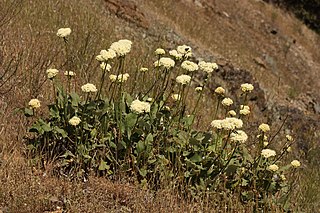
Eriogonum is a genus of flowering plants in the family Polygonaceae. The genus is found in North America and is known as wild buckwheat. This is a highly species-rich genus, and indications are that active speciation is continuing. It includes some common wildflowers such as the California buckwheat.

Eriogonum nudum is a perennial shrub of the wild buckwheat genus which is known by the common name naked buckwheat or nude buckwheat.

Eriogonum fasciculatum is a species of wild buckwheat known by the common names California buckwheat and flat-topped buckwheat. Characterized by small, white and pink flower clusters that give off a cottony effect, this species grows variably from a patchy mat to a wide shrub, with the flowers turning a rusty color after blooming. This plant is of great benefit across its various habitats, providing an important food resource for a diversity of insect and mammal species. It also provides numerous ecosystem services for humans, including erosion control, post-fire mitigation, increases in crop yields when planted in hedgerows, and high habitat restoration value.

Eriogonum deflexum is a species of wild buckwheat known by the common names flatcrown buckwheat, flat-top buckwheat, and skeletonweed. This plant is native to the southwestern United States and northwestern Mexico, where it is common and grows in a variety of habitats, especially desert scrub. It is somewhat weedy where it is most abundant. This is an annual which varies in size from small patches on the ground to tangled bushes approaching two meters in height; it may be dense or thin and spindly. This is a brown or greenish weedy-looking herb with a many-branched stem. The leaves are located at the base of the plant and are rounded and woolly and one to four centimeters long. Small clusters of flowers appear at intervals along the branches with each flower only one to three millimeters wide and white or pinkish in color.
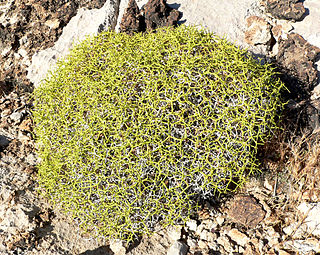
Eriogonum heermannii is a species of wild buckwheat known by the common name Heermann's buckwheat. It is native to the southwestern United States from California to Utah where it grows on rocky slopes, desert flats, and dry washes.

Eriogonum nidularium is a species of wild buckwheat known by the common name birdnest buckwheat. It is native to the sandy flats and desert dry washes of the Mojave Desert and Great Basin in the western United States, where it is common and abundant. This is a distinctive annual herb producing a thin, multibranched stem which curves in on itself to form a rounded, tangled mass.

Eriogonum wrightii is a species of wild buckwheat known by the common names bastardsage and Wright's buckwheat. It is native to the Southwestern United States, California, and northwest Mexico, where it grows in many plant communities, such as chaparral, in rocky habitats from mountains to deserts.
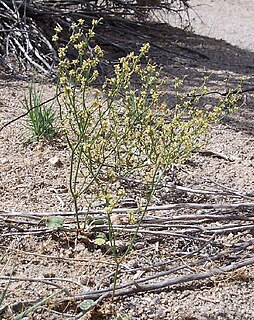
Eriogonum ampullaceum is a species of wild buckwheat known by the common name Mono buckwheat.

Eriogonum angulosum is a species of wild buckwheat known by the common name anglestem buckwheat.

Eriogonum brachyanthum is a species of wild buckwheat that is commonly known as shortflower buckwheat. It is native to eastern California and western Nevada, particularly the Mojave Desert region, where it is common to abundant, and even sometimes weedy. It is also known from southern Oregon. The plant grows in sandy habitats such as desert flats and sagebrush. It also grows in pinyon-juniper and montane conifer woodlands. It is an annual herb that grows 30 to 40 centimeters tall. Leaves are located at the base of the stem, woolly, and oval or rounded in shape. The top of the stem is occupied by a branching inflorescence bearing many widely spaced clusters of flowers. Each individual flower is about a millimeter wide and light yellow in color. Flowers bloom from April to November.
Eriogonum deserticola is a species of wild buckwheat known by the common name Colorado Desert buckwheat.

Eriogonum gracile is a species of wild buckwheat known by the common name slender woolly buckwheat.
Eriogonum hookeri is a species of wild buckwheat known by the common name Hooker's buckwheat. It is native to the Intermountain West of the United States, where it grows in plateau and desert habitat.

Eriogonum palmerianum is a species of wild buckwheat known by the common name Palmer's buckwheat. It is native to the Southwestern region of the United States and Great Basin region, where it grows in many types of desert and sagebrush plateau habitat.
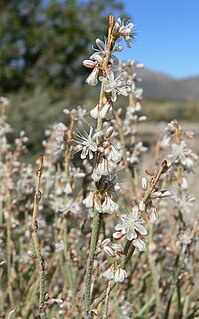
Eriogonum panamintense is a species of wild buckwheat known by the common name Panamint Mountain buckwheat. It is native to several of the desert mountain ranges of eastern California and western Nevada, including the Panamint Range. It grows in various types of mountain ridge habitat, such as sagebrush and coniferous woodland.
Eriogonum rixfordii is an uncommon species of wild buckwheat known by the common name pagoda buckwheat. It is native to the Mojave Desert, where it grows in California's Death Valley and adjacent parts of Nevada.

Eriogonum sphaerocephalum is a species of wild buckwheat known by the common names rock buckwheat and round-headed desert buckwheat. It is native to the western United States.
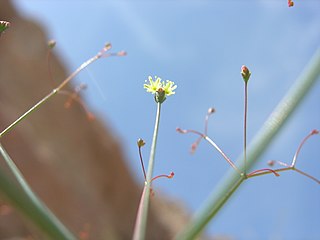
Eriogonum thomasii is a species of wild buckwheat known by the common name Thomas' buckwheat. It is native to the desert southwest of the United States and northern Mexico where it is common in many areas, sometimes becoming a weed.

Eriogonum gypsophilum is a rare species of wild buckwheat known by the common names Seven River Hills buckwheat and gypsum wild buckwheat. It is endemic to the state of New Mexico in the United States, where it is known from only three sites in Eddy County. It is limited to a specific type of soil which is high in gypsum. The plant has been federally listed as a threatened species of the United States since 1981.

Eriogonum abertianum, with the common names Abert's buckwheat and Abert wild buckwheat, is a species of buckwheats in the family Polygonaceae.

















